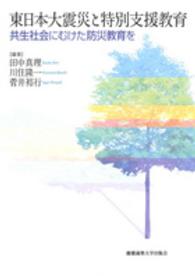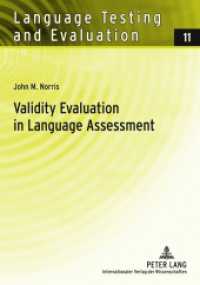- ホーム
- > 洋書
- > 英文書
- > Science / Mathematics
基本説明
Part one provides an introduction to computer vision in the food and beverage industries, discussing computer vision and infrared techniques for image analysis, hyperspectral and multisupectral imaging, tomographic techniques and image processing. Part two goes on to consider computer vision technologies for automatic sorting, foreign body detection and removal, automated cutting and image analysis of food microstructure.
Full Description
The use of computer vision systems to control manufacturing processes and product quality has become increasingly important in food processing. Computer vision technology in the food and beverage industries reviews image acquisition and processing technologies and their applications in particular sectors of the food industry.Part one provides an introduction to computer vision in the food and beverage industries, discussing computer vision and infrared techniques for image analysis, hyperspectral and multispectral imaging, tomographic techniques and image processing. Part two goes on to consider computer vision technologies for automatic sorting, foreign body detection and removal, automated cutting and image analysis of food microstructure. Current and future applications of computer vision in specific areas of the food and beverage industries are the focus of part three. Techniques for quality control of meats are discussed alongside computer vision in the poultry, fish and bakery industries, including techniques for grain quality evaluation, and the evaluation and control of fruit, vegetable and nut quality.With its distinguished editor and international team of expert contributors, Computer vision technology in the food and beverage industries is an indispensible guide for all engineers and researchers involved in the development and use of state-of-the-art vision systems in the food industry.
Contents
Contributor contact detailsAbout the editorWoodhead Publishing Series in Food Science, Technology and NutritionPart I: An introduction to computer vision in the food and beverage industriesChapter 1: Computer vision and infrared techniques for image acquisition in the food and beverage industriesAbstract:1.1 Introduction1.2 The electromagnetic spectrum1.3 Image acquisition systems1.4 Conclusions1.6 Appendix: nomenclature and abbreviationsChapter 2: Hyperspectral and multispectral imaging in the food and beverage industriesAbstract:2.1 Introduction2.2 Spectral image acquisition methods2.3 Construction of spectral imaging systems2.4 Calibration of spectral imaging systems2.5 Spectral images and analysis techniques2.6 Applications for food and beverage products2.7 ConclusionsChapter 3: Tomographic techniques for computer vision in the food and beverage industriesAbstract:3.1 Introduction3.2 Nuclear tomography3.3 Electrical impedance3.4 Image reconstruction3.5 Applications3.6 Conclusions3.8 Appendix: nomenclature and abbreviationsChapter 4: Image processing techniques for computer vision in the food and beverage industriesAbstract:4.1 Introduction4.2 Digital image analysis techniques4.3 Classification4.4 Relevance, impact and trends for the food and beverage industry4.5 ConclusionsPart II: Computer vision applications in food and beverage processing operations/technologiesChapter 5: Computer vision in food processing: an overviewAbstract:5.1 Introduction to computer vision5.2 Technology selection5.3 Selection of image analysis methods5.4 Application examples5.5 ConclusionChapter 6: Computer vision for automatic sorting in the food industryAbstract:6.1 Introduction6.2 Basic techniques and their application6.3 Advanced techniques and their application6.4 Alternative image modalities6.5 Special real-time hardware for food sorting6.6 Recent advances in computer vision for food sorting6.7 Future trends6.8 Conclusion6.10 AcknowledgementsChapter 7: Computer vision for foreign body detection and removal in the food industryAbstract:7.1 Introduction7.2 Optical inspection7.3 Fundamentals of X-ray inspection7.4 X-ray inspection of food products7.5 ConclusionsChapter 8: Automated cutting in the food industry using computer visionAbstract:8.1 Introduction8.2 Machine vision and computer vision8.3 Feature selection, extraction and analysis8.4 Machine learning algorithms8.5 Application examples: sensing for automated cutting and handling8.6 Future trends8.7 Conclusions8.8 AcknowledgmentsChapter 9: Image analysis of food microstructureAbstract:9.1 Introduction9.2 Quality control applications of digital imaging9.3 Characterizing the internal structure9.4 Volume, surface and length9.5 Number and spatial distribution9.6 Surfaces and fractal dimensions9.7 ConclusionsPart III: Current and future applications of computer vision for quality control and processing of particular productsChapter 10: Computer vision in the fresh and processed meat industriesAbstract:10.1 Introduction10.2 Meat image features10.3 Application and implementation10.4 Application and implementation for lamb, pork and other processed meats10.5 Future trends10.6 ConclusionsChapter 11: Real-time ultrasound (RTU) imaging methods for quality control of meatsAbstract:11.1 Introduction11.2 Historical background on ultrasound use for carcass composition and meat traits evaluation11.3 Basic ultrasound imaging principles11.4 Applications of real-time ultrasound (RTU) to predict carcass composition and meat traits in large animals11.5 Applications of RTU to predict carcass composition and meat traits in small animals and fish11.6 Using real-time ultrasonography to predict intramuscular fat (IMF) in vivo11.7 Optimization of production system and market carcass characteristics11.8 The future of RTU imaging in the meat industry11.9 ConclusionChapter 12: Computer vision in the poultry industryAbstract:12.1 Introduction12.2 Poultry processing applications12.3 Development of spectral imaging for poultry inspection12.4 Case studies for online line-scan poultry safety inspection12.5 Future trends12.6 ConclusionsChapter 13: Computer vision in the fish industryAbstract:13.1 Introduction13.2 The need for computer vision in the fish industry13.3 Automated sorting and grading13.4 Automated processing13.5 Process understanding and optimization13.6 Challenges in applying computer vision in the fish industry13.7 Future trends13.8 Further information13.9 ConclusionsChapter 14: Fruit, vegetable and nut quality evaluation and control using computer visionAbstract:14.1 Introduction14.2 Basics of machine vision systems for fruit, vegetable and nut quality evaluation and control14.3 Applications of computer vision in the inspection of external features14.4 Real-time automatic inspection systems14.5 Future trends14.6 Conclusions14.7 Sources of further information14.8 AcknowledgementsChapter 15: Grain quality evaluation by computer visionAbstract:15.1 Introduction15.2 Colour imaging15.3 Hyperspectral imaging15.4 X-ray imaging15.5 Thermal imaging15.6 Conclusions15.7 AcknowledgementsChapter 16: Computer vision in the bakery industryAbstract:16.1 Introduction16.2 Computer vision applications for analysing bread16.3 Computer vision applications for analysing muffins16.4 Computer vision applications for analysing biscuits16.5 Computer vision applications for analysing pizza bases16.6 Computer vision applications for analysing other bakery products16.7 Future trends and further information16.8 ConclusionsChapter 17: Development of multispectral imaging systems for quality evaluation of cereal grains and grain productsAbstract:17.1 Introduction17.2 Hyperspectral imaging17.3 Detection of mildew damage in wheat17.4 Detection of fusarium damage in wheat17.5 Sprout damage in wheat17.6 Determination of green immature kernels in cereal grains17.7 Effect of mildew on the quality of end-products17.8 Development of multispectral imaging systems17.9 Conclusions17.10 AcknowledgementsIndex








